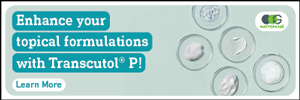Bioavailability & Solubility
WHITEPAPER - Infographic-Zydis® Orally Disintegrating Tablet (ODT) vs. Standard Tablets (ST)
Catalent’s proprietary Zydis® ODT platform is backed by a large number of clinical studies. This infographic provides a high level summary of studies comparing Zydis ODT against traditional oral tablets…..
FORMULATION FORUM - Sterile & Non-Sterile Formulation Capabilities - A CDMO Perspective
Jim Huang, PhD, and Shaukat Ali, PhD, explain how their company is expanding its footprints in sterile manufacturing to handle innovative molecules and leverage its services to emerging and specialty and biopharma companies requiring cGMP materials for preclinical tox and clinical studies.
DRUG-ELUTING IMPLANTS - Sustained-Release Implants - A Targeted Approach to Drug Delivery
Tom Quinci, MSc, believes oncology requires new treatment modalities that are better for patients, and it is time technologies like drug-eluting implants, offering real, achievable advantages, are more widely considered.
ROUNDTABLE DISCUSSION - Which Trends Will Have the Most Impact on Drug Development in 2023?
Contributor Cindy H. Dubin posed this question to life science leaders during a recent roundtable discussion, and one common theme is the focus on sustainability in pharmaceutical development.
FUNCTIONAL EXCIPIENTS - Improving the Water Solubility of Oral Drugs With Amorphous Solid Dispersions (ASDs)
Liliana Miinea, PhD, says with certain polymers, it is possible for drug formulators to take full advantage of the benefits of ASDs, enabling them to overcome formulation challenges to deliver more effective novel drug products capable of transforming the lives of patients.
FORMULATION DEVELOPMENT - Understanding CBD Formulation Versus Dosage Format
Gerry McNally, PhD, says there are many misconceptions when it comes to considering the best way or format to consume CBD and get the maximum benefit. Formulation scientists need to consider several factors when developing new formulations of nutraceutical ingredients, especially botanical ingredients and natural materials from various sources.
Celltrion & Rani Therapeutics Partner on Development of Oral Monoclonal Antibody Treatment
Rani Therapeutics Holdings, Inc. recently announced it has partnered with Celltrion for the development of RT-111, an orally administered ustekinumab biosimilar….
2023 COMPANY PROFILES & CAPABILITIES
For each participating company, this section presents a detailed summary highlighting their core technologies, capabilities, technologies, and services.
NovaQuest Private Equity Announces Investment In Bend Bioscience to Broaden CoreRx Offering
Bend Bioscience and QHP Capital (the management company for NovaQuest Private Equity) have recently announced plans to invest in a new operation in Bend, OR,…
FORMULATION FORUM - Lipid Nanoparticles: Tackling Solubility Challenges With Lipid-Based Technologies for Oral & Injectable Formulations
Jim Huang, PhD, and Shaukat Ali, PhD, believe as more hydrophobic or brick dust and/or lipophilic or waxy molecules come out of discovery, amorphous solid dispersions (ASDs) and lipid based self-emulsifying microemulsions, nanoemulsions, liposomes, and nanoparticles are ideal for oral and injectable formulations.
Ascendia Pharmaceuticals Named to Inc. 5000 List of America’s Fastest-Growing Private Companies for Third Consecutive Year
Ascendia Pharmaceuticals recently announced it has been named to the prestigious Inc. 5000 rankings of the fastest growing privately-owned companies in the United States for…
NANOPARTICLE ENGINEERING - Lighting the Way to a Patient-Centric Future
Christopher Worrall, PhD, discusses how nanoparticle engineering technologies could help improve compliance and patient outcomes, for both small-molecule and biological drugs, and how nanotechnology can help facilitate a shift toward more patient-centric medicine.
Aptose’s New G3 Formulation of Luxeptinib Boosts Bioavailability
Aptose Biosciences Inc. recently announced the G3 formulation of luxeptinib, designed for rapid and efficient absorption, demonstrates approximately an 18-fold improvement in oral bioavailability….
SOLUBILITY ENHANCEMENT - How Microparticles are Opening Doors to New Solutions for Oral Drug Delivery
Jessica Mueller-Albers, PhD, Yiming Ma, PhD, Alexander Bernhardt, PhD, and Michael Damm review the use of microparticles for solubility enhancement of oral small molecules and how this approach can address the challenges in pharmaceutical formulations.
Zerion Pharma & Hovione Extend Partnership to Cover Use of Dispersome Technology Platform in Nutraceuticals
Hovione and Zerion Pharma A/S (Zerion) recently announced an extension of their collaboration on Zerion’s Dispersome technology into the nutraceutical/dietary….
Lonza Strengthens Micronization Portfolio With the Introduction of X-Ray Powder Diffraction Capability
Lonza has expanded the range of particle engineering services offered by its Monteggio (CH) site through the introduction of X-ray powder diffraction (XRPD). This rapid analytical technique provides additional….
Cardiovascular Patients on Aspirin Therapy Prefer VAZALORE 81 mg
PLx Pharma Inc. is a commercial-stage drug delivery platform technology company focused on its clinically validated and patent-protected PLxGuard that has the potential to improve…
Catalent to Acquire Metrics Contract Services for $475 Million
Catalent, Inc. recently announced it has reached an agreement to acquire Metrics Contract Services (Metrics), a full-service specialty Contract Development and Manufacturing Organization (CDMO) with a facility in….
Lexaria Bioscience Developing Powerful Tech to Treat Hypertension
Lexaria Bioscience Corp. recently announced its placement in an editorial published by NetworkNewsWir, one of 50+ trusted brands within the InvestorBrandNetwork, a multifaceted financial news…
Starton Therapeutics Reports Positive Results From Phase 1 Study Evaluating Continuous Delivery Lenalidomide
Starton Therapeutics Inc. recently announced positive results from high-level data from its Phase 1 study of STAR-LLD, evaluating the pharmacokinetics (PK) and safety of the company’s continuous delivery….
Bioavailability and Solubility Challenges
Given that a large number of drugs fail to reach the market due to poor solubility and bioavailability, the industry is seeking various methods to mitigate this challenge while many choose to re-formulate existing product candidates. Either way, the demand for novel bioavailability and solubility enhancement methods has grown significantly. To cater to this increasing demand, many contract manufacturers and technology developers have emerged.
What is Solubility?
Solubility is the ability for a drug to be dissolved in an aqueous medium. Drug solubility is defined as the maximum concentration of a substance that can be completely dissolved in a given solvent at a certain temperature and pressure level.
Solubility of drugs is measured by the amount of solvent needed to dissolve one gram of the drug at a specific temperature. For example, a drug that is very soluble needs less than one part solvent to dissolve one gram of the drug. How soluble a drug is varies widely—a drug that is considered soluble needs 10-30 parts, one that is slightly soluble needs 100-1,000 parts and one that is practically insoluble or insoluble needs more than 10,000 parts. How soluble a drug is depends on the solvent, as well as temperature and pressure.
Since 1975, approximately 60 marketed drugs have leveraged solubilization technologies to enhance oral bioavailability. In the preceding 36 years, from the time the FDA required submission of an NDA in 1938, solubilization technology was virtually unused on a regular basis. Apparently, the disease areas focus, drug discovery methodologies, and the lack of mature solubilization platforms restricted the use prior to the 1970s.
In comparison, the past nearly 4 decades have shown robust growth in the reliance on solubilization platforms, accounting on average for around 9% of all NMEs approved from 1975 through 2022, and more than 10% in the past decade. Some years stand out to validate the need and use of solubilization platforms. For example, in 2005, 20% of NMEs approved used technologies including solid dispersion, lipid, and nanocrystal platforms. The data for the most recent 4-year period (2010-2013) seems to represent a slight decline in growth, but it is still early in the decade, and the data set is relatively small. Based on the trends throughout the past 4 decades and the changing chemical space in drug development, we expect the decade will show additional and significant current growth in use of solubilization technologies once we have visibility into the full 10-year period.
Bioavailability & Solubility Impediments
The biggest impediment in addressing bioavailability issues likely lies with a lack of deep familiarity with enabling technologies. Improving drug bioavailability begins with a thorough evaluation of the API’s physical and chemical properties in relation to solubilization in the dose, but more importantly its dissolution in vivo at the site of absorption.
These technologies, such as nanoparticles, cocrystals, computer-aided prodrug design, and electrospinning, represent innovations aimed at enhancing the solubility of a candidate molecule, particularly in the gastrointestinal tract. Technologies such as electrospinning, deep eutectic solvents, and ionic liquids are upcoming formulation approaches to enhance drug solubility, and as the science matures, and the relative strengths and weaknesses are better understood, we expect to see further application of these innovative approaches. They have shown to be successful for some compounds, and have a place alongside other bioavailability enhancement technologies, where each strategy has its benefits and corresponding liabilities. For them to be successful and widely adopted however, they will also have to provide a compelling benefit compared with other well-understood, and commercially precedented technologies, such as amorphous solid dispersions and lipid-based formulations.
Extreme compounds require either significant amounts of stabilizers to maintain the amorphous state or they are not amenable to common manufacturing technologies with reasonable cost of goods due to their low solubility in organic solvents. These include amorphous solid dispersions using polymethacrylate, cellulose, or povidone-based polymeric carriers, she says. In addition, thermostability of new molecular entities becomes an issue as most new molecules have melting points well above 400°F. Alternative production methods for amorphous solid dispersions can address these issues.














